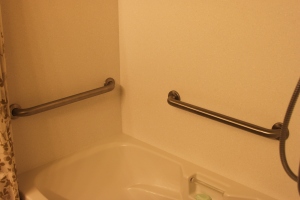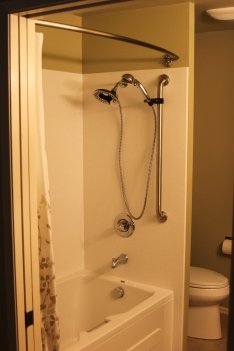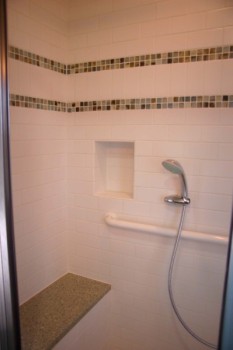If a bad accident, illness, or mobility issues due to aging should happen to you or a loved one, would you have to move out of your home? Most existing homes are not designed for mobility impaired persons.
When contemplating a bathroom remodel, many are including UD or CAPS principles included in the design process. With modern materials and products this need not cause your bathroom to look like a hospital room! Far from it. A brief review online will impress you with all the stylish designs that are out there.
What are the qualities a handicapped accessible bathroom will have? Here are 5 criteria:
- Plenty of room for access and to maneuver a wheelchair. Not all mobility impaired persons will be using a wheelchair, but designing the room to accommodate one will meet or exceed any special needs. Provide for an open area within the bathroom that’s at least 5 feet in diameter to allow for easy turning. Also provide 4 feet of clear space in front of each fixture, as well as between the sink and the toilet, if both fixtures share the same wall. These spaces also will allow room for a caregiver, if needed.
- Doorways should be 3 feet wide, so a wheelchair can easily pass through.
- Select a vanity that is open underneath, so a person in a wheelchair can pull in.
- The shower should have no threshold so a wheelchair can enter. Control valves and shower heads should be at two different heights, or there should be a handheld nozzle. Provide grab bars and a built in seat.
- The toilet should be at ADA specified height, with grab bars for safety in rising and seating oneself.
That is a good start! There are other things that should be considered, such as non-slippery flooring materials, adequate lighting, and faucets that are designed to prevent scalding. Of course, all light switches should be low enough so a person in a wheelchair can easing reach them. There are ADA approved faucet handles, or even touch-free units, as well as door knobs of the blade-type, that are easier to use than the standard round knobs. Not all of the possible handicapped accessible design concepts need to be included in every CAPS designed bathroom, only those that the owner feels would work for them.
DyLon McClary, the owner of Rose Construction, is experienced and certified in CAPS design, and we would be happy to assist you with design and construction of your next bathroom remodel, incorporating the principles of Universal Design and Certified Aging in Place. Give us a call!





